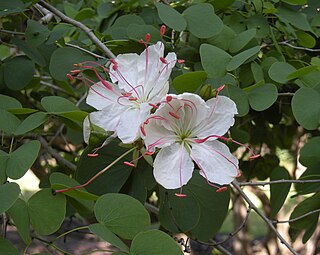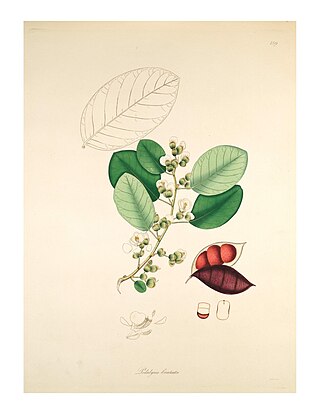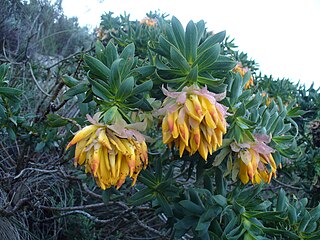
Pterocarpus is a pantropical genus of trees in the family Fabaceae. It belongs to the subfamily Faboideae, and was recently assigned to the informal monophyletic Pterocarpus clade within the Dalbergieae. Most species of Pterocarpus yield valuable timber traded as padauk, usually pronounced or ; other common names are mukwa or narra. The west African species may be traded as African rosewood. P. santalinus also yields the most precious red sandalwood in China known as Zitan. The wood from the narra tree and the Burmese padauk tree is marketed as amboyna when it has grown in the burl form. The scientific name is Latinized Ancient Greek and means "wing fruit", referring to the unusual shape of the seed pods in this genus.
Angylocalyx is a genus of flowering plants in the family Fabaceae. It includes seven species native to sub-Saharan Africa, ranging from Guinea to Angola, Tanzania, and Kenya.

Baphia is a small genus of legumes that bear simple leaves. Baphia is from the Greek word βάπτω, referring to a red dye that is extracted from the heartwood of tropical species. The genus is restricted to the African tropics. Baphia was traditionally assigned to the tribe Sophoreae; however, recent molecular phylogenetic analyses reassigned Baphia to the tribe Baphieae.

Kotschya is a genus of legumes in the family Fabaceae. It includes 30 species native to sub-Saharan Africa. The genus was recently assigned to the informal monophyletic Dalbergia clade of the Dalbergieae. It contains the following species:

Melolobium is a genus of flowering plants belonging to the legume family, Fabaceae. It includes 14 species of small shrubs or perennial herbs native to southern Africa, which are found in southern and eastern Namibia, southwestern Botswana, and most of South Africa.
Ormocarpum is a genus of flowering plants in the legume family, Fabaceae. It includes 17 species native to tropical and southern Africa and parts of India, Indochina, Malesia, Papuasia, and the South Pacific. The genus was recently assigned to the informal monophyletic Dalbergia clade of the Dalbergieae.

Pericopsis is a genus of flowering plants in the legume family, Fabaceae. It includes four species of trees and shrubs, three native to sub-Saharan Africa and one to Sri Lanka, Malesia, New Guinea, and the Caroline Islands. Typical habitats include tropical lowland forest and seasonally-dry woodland and wooded grassland.

Lysiphyllum is a genus of flowering plants in the legume family, Fabaceae. It includes nine species of trees, semi-scandent shrubs, and lianas which range from India through Southeast Asia to Australasia. Typical habitats include seasonally-dry tropical forest and woodland, vine thickets, Brigalow and Gidgee scrubland, floodplains, alluvial flats, tidal forest, mangroves, river and stream banks, and occasionally dunes and coral islets. They can grow on diverse soils including calcareous, granitic, and basaltic.

Piliostigma is a genus of flowering plants in the legume family, Fabaceae. It includes five species of small deciduous trees native to sub-Saharan Africa, the Indian subcontinent, Indochina, Java, the Philippines, and northern Australia. It belongs to the subfamily Cercidoideae and the tribe Bauhinieae. It is dioecious, with male and female flowers on separate plants.

Argyrolobium is a genus of flowering plants in the family Fabaceae. It belongs to the subfamily Faboideae. Members of this genus are found in Africa, western and south Asia, and southern Europe.
Baphiopsis parviflora is an African species of flowering plants in the legume family, Fabaceae. It is the sole species in genus Baphiopsis. It is a shrub or tree which ranges from Cameroon to Tanzania and Angola.

Bolusanthus speciosus is a species of flowering plants in the family Fabaceae. It belongs to the subfamily Faboideae. It is the only member of the genus Bolusanthus.
Clathrotropis is a genus of flowering plants in the family Fabaceae. It includes 7 species native to northern South America, ranging from Peru to Colombia, Venezuela, the Guianas, and northern Brazil. The genus belongs to subfamily Faboideae.

Dalhousiea is a genus of flowering plants in the legume family, Fabaceae. It belongs to the subfamily Faboideae. It includes two species, one native to central Africa, and the other to eastern India, Bangladesh, and Myanmar.
Fiebrigiella gracilis is a species of flowering plants in the legume family, Fabaceae. It is the only member of the genus Fiebrigiella. It belongs to the subfamily Faboideae, and was recently assigned to the informal monophyletic Pterocarpus clade of the Dalbergieae. It is a subshrub native to Ecuador, Peru, and Bolivia.
Mildbraediodendron excelsum is a species of flowering plant in the family Fabaceae, and the only species in the genus Mildbraediodendron. It is a tree native to sub-Saharan Africa, ranging from Ghana to South Sudan, Uganda, and Democratic Republic of the Congo. It grows in Guineo-Congolian forest and Victoria Basin forest–savanna mosaic. It belongs to the subfamily Faboideae.
Riedeliella is a genus of flowering plants in the legume family, Fabaceae. It includes three species of scandent shrubs native to Paraguay and eastern and west-central Brazil. They grow in seasonally-dry tropical forest, cerrado, and caatinga. The genus belongs to the subfamily Faboideae, and was recently assigned to the informal monophyletic Pterocarpus clade within the Dalbergieae.

Liparia is a genus of flowering plants in the legume family, Fabaceae. It includes 20 species native to the Cape Provinces of South Africa. It belongs to the subfamily Faboideae.
Lasiobema was a genus of flowering plants in the legume family, Fabaceae, most of which are lianas, belonging to the subfamily Cercidoideae. It was recently (2010) synonymized with Phanera on the basis of morphology, although this was questioned and it can be treated as a section of this genus.

Schnella is a genus of flowering plants in the legume family, Fabaceae. It belongs to the subfamily Cercidoideae. All of its species are neotropical lianas.












